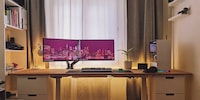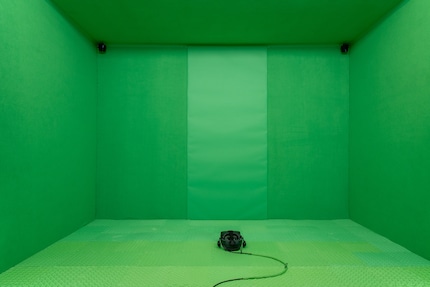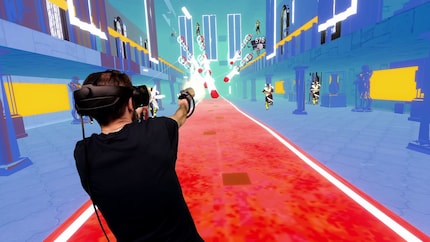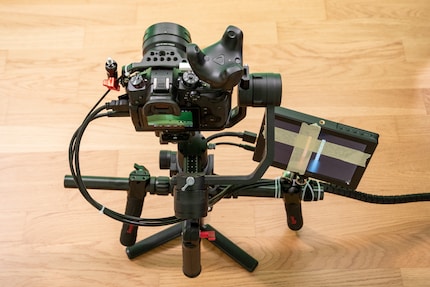
Background information
Community desk setups: every article
by David Lee

You can’t sit down at this workstation. There’s no chair, not even a desk. Just plenty of exceptional digital technology. Welcome to Andy’s MR Studio.
We asked you to show us your workplaces. What Andy sent us isn’t a workplace in the exact sense. Andy can’t sit at a desk or write e-mails there. And yet, it fits. It’s a place where a certain kind of work is done – and games are played.

On a hot July day, the three of us stand here in a relatively small, bright green room. Andy breaks down his studio to my colleague Michelle and me. The black thing in the centre of the photo above is a pair of VR glasses. This place is designed to play VR games comfortably. The room is empty and the walls are soft – the player doesn’t run the risk of tripping or damaging anything.
But this space isn’t just for gaming, and that’s why it’s green. The room serves as a video studio too. Green is usually the colour used for chroma keying in videos. In other words, the green background is filtered out. This allows the subject to be detached from their background and inserted into a different scene.
In this case, this means the person playing a VR title can be inserted into the game itself. This is known as MR, or mixed reality.

In a VR game, a player sees the game world, but not themselves. For everyone else, it’s the other way around. Nobody sees both – i.e. the player in the game. The gamer and others are completely visually separated. Andy’s videos bring these two worlds together. They show off VR demos better, giving a more accurate impression of how they feel to play.
Andy’s been working in this field for around five years. It’s primarily a hobby. But as is the case with hobbies, they can escalate. He spent five months building the studio, for a total of around 15,000 francs. Here’s a time-lapse of construction. Incidentally, the window behind the green wall is still accessible – the middle section can be removed.
Andy now receives requests too, mostly from smaller game developers. They want to show what their game looks like to the person playing it, but don’t have the opportunity to produce these demos themselves.
The VR headset used is the Valve Index. It isn’t nearly as new as the Meta Quest 3, but it’s better for Andy’s purposes. Good synchronisation between his camera and the game is particularly important to him.
Andy has mounted three HTC Vive Base Stations 2.0 for positioning, two of which can be seen in the upper corners of the picture. The base stations track the glasses and both controllers. An HTC Vive Tracker is mounted on the camera. This means that the perspective of the game moves when the camera is moved during recording.
Base stations and trackers are the reason why Andy doesn’t use the Meta Quest 3 – it isn’t compatible with them. It tracks the controllers using its own cameras in the headset. Camera and game footage would have to be synchronised with additional software.
When it was released in 2021, the Panasonic Lumix GH5 II was one of the few cameras that could shoot unlimited 4K at 60 frames per second without overheating. With fast movements and sometimes longer recording sessions, it was perfectly suited for Andy.

In addition to the person playing, a second person is needed to operate the camera. At least if the camera won’t stay in place, but will be carried around during the recording. A gimbal is required to ensure smooth camera movements. Andy bought the DJI Ronin-S second-hand. He previously used a GoPro Hero as his camera. Although it can be placed practically anywhere, it lacks a thread for mounting the tracker. Its picture quality isn’t nearly as good either.
The camera is wired to the PC in the same way as the VR glasses. Since latency should be as low as possible, there’s no other option. The cables are neatly routed and bundled throughout and can’t become tripping hazards.
When Andy started making MR videos five years ago, there were only a few people doing it in this style – with studio lighting and green screen. And only for a few suitable games. Things are different now. Andy’s favourite is rhythm game Beat Saber. In his experience, it can be played longer than other VR games without causing dizziness. In the long run, however, it becomes exhausting.
A lot of work goes into making an MR video, Andy estimates an average of 15 hours. Recording itself makes up a smaller part, about three to four hours, the rest is all post-production.
Andy wouldn’t get very far on his own – if only because of the camera work. He usually makes recordings with his girlfriend, who’s also a passionate Beat Saber fan.
At times, Andy posted two videos a week on his Instagram. But he wasn’t happy with this rhythm – he felt he was doing it primarily to satisfy the Instagram algorithm. These days, Andy prefers to produce fewer but better videos.
For example, he’s started to merge game and camera footage after the fact, although this can be done live too. However, post-processing offers significantly more control over colour and exposure of the camera image.
On his PC, Andy uses the software LIV, a tool for creating MR content. He then finalises the result in OBS Studio.
Andy is largely satisfied with his current setup. Of course, state-of-the-art glasses would be nice – but they also have to meet his special requirements for synchronisation. A holder to additionally support the camera is on his wishlist too. When recording for hours on end, carrying it just in your free hand can be a bit tedious. According to Andy, the studio lighting could also be improved. Keep in mind, the current LED panels already draw up to 400 watts and get pretty hot too. That afternoon, despite all our curiosity, we were glad to get out of the studio again.
My interest in IT and writing landed me in tech journalism early on (2000). I want to know how we can use technology without being used. Outside of the office, I’m a keen musician who makes up for lacking talent with excessive enthusiasm.
Interesting facts about products, behind-the-scenes looks at manufacturers and deep-dives on interesting people.
Show all